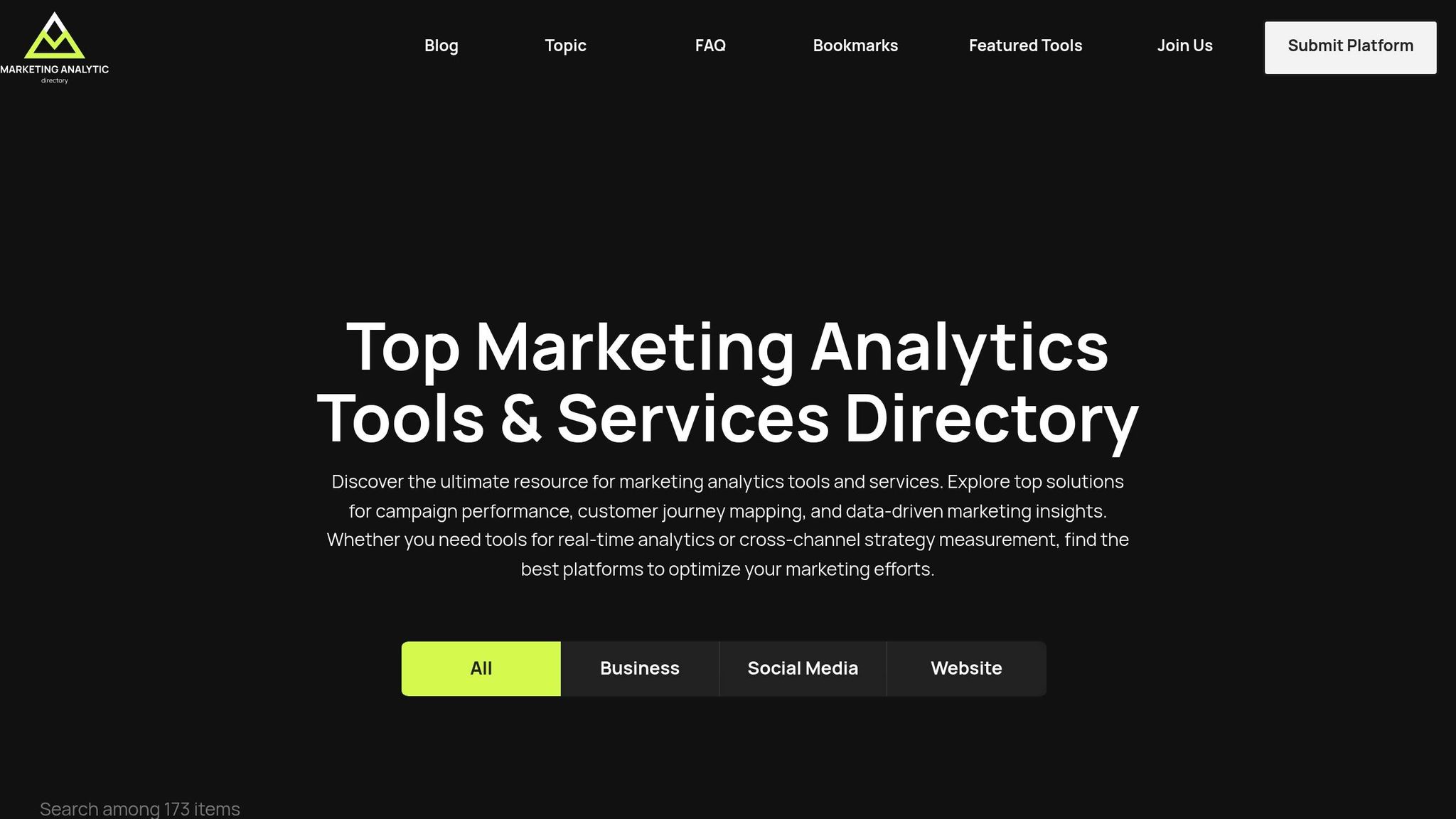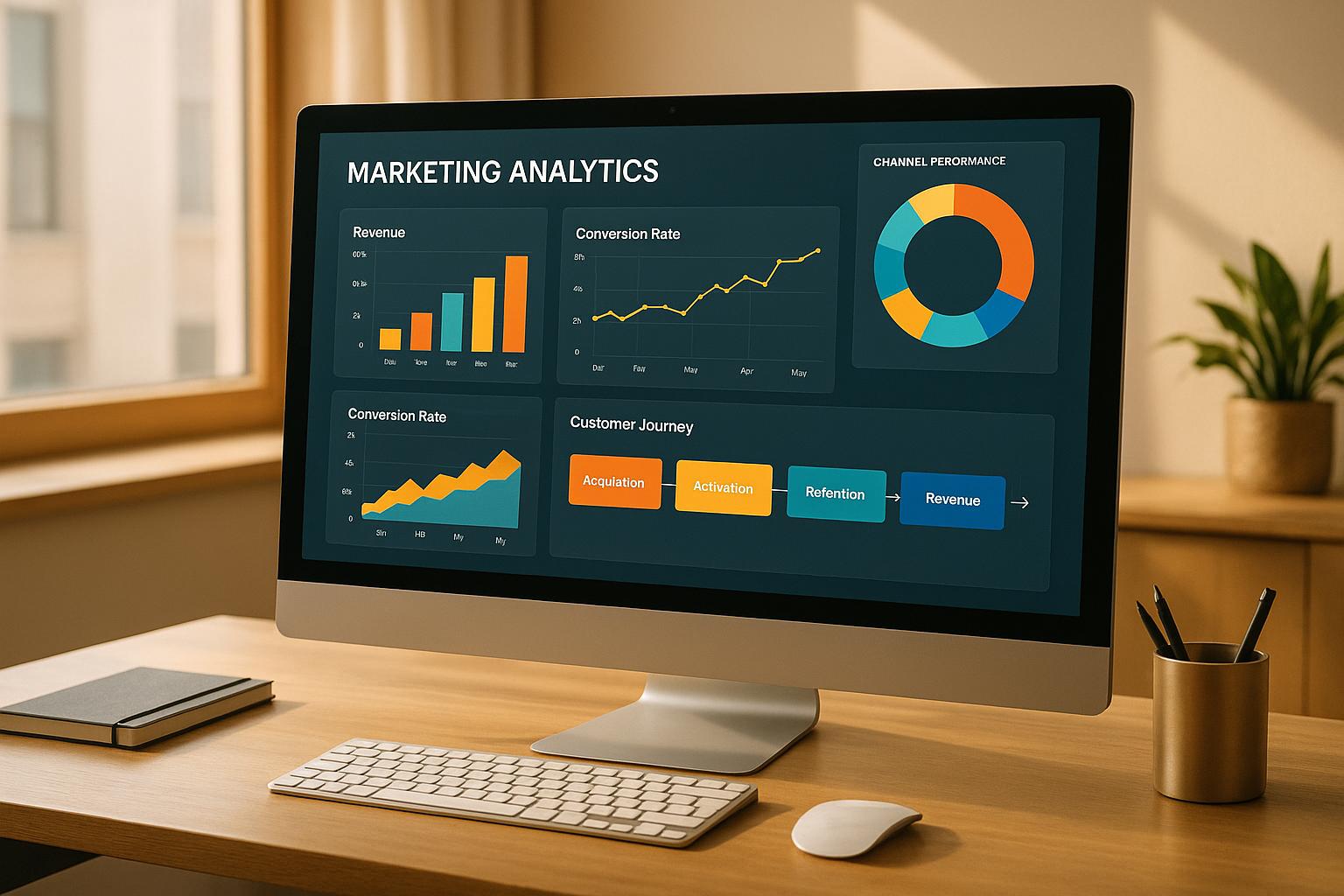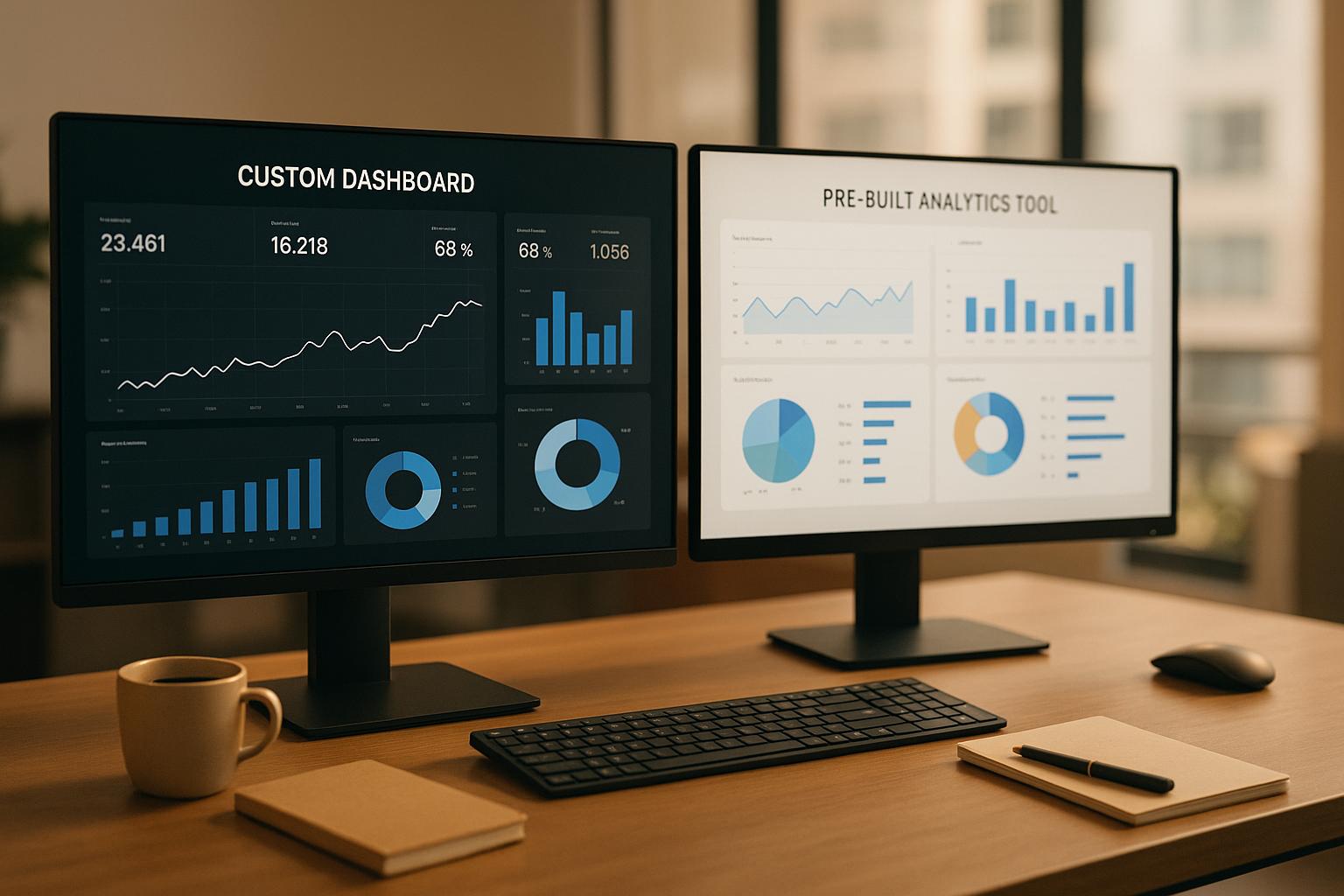Choosing between free and paid dashboards depends on your business needs, budget, and data complexity. Free tools are great for basic insights, while paid options provide advanced features for growing businesses or enterprises.
Key Takeaways:
- Free Dashboards: Ideal for startups, small teams, or individual analysts. They offer basic functionality, cost savings, and quick setup but lack customization, integrations, and scalability.
- Paid Dashboards: Designed for larger organizations or those with complex data needs. They provide advanced analytics, robust integrations, and enterprise-level scalability but come with higher costs and may require training.
Quick Comparison:
| Feature | Free Dashboards | Paid Dashboards |
|---|---|---|
| Cost | Free or freemium | $10–$100+ per user/month |
| Customization | Limited | Extensive |
| Integrations | Few platforms | Broad compatibility |
| Scalability | Suitable for small teams | Supports large enterprises |
| Support | Community forums or guides | Dedicated customer service |
| Security | Basic | Advanced, enterprise-grade |
Start with free tools for essential monitoring. Upgrade to paid dashboards as your business grows or data needs become more complex. Tools like Power BI, Tableau, and Looker dominate the enterprise space, while free options like Google Data Studio work well for simpler setups.
Free Real-Time Dashboard Tools
What Are Free Dashboard Tools?
Free dashboard tools provide real-time data visualization without any initial cost. These tools come in two main forms: open-source platforms and freemium models. Unlike static dashboards, they continuously update to provide live insights. Common features include management strategic dashboards, SaaS management dashboards, sales KPI tracking, and basic reporting capabilities.
These tools are particularly useful in smaller-scale settings where budgets are tight. Startups, small marketing teams, non-profits, and individual analysts often rely on them for essential data visualization without the financial burden of enterprise-grade software. While they help users track trends, identify issues, and make quicker decisions, their functionality is often more limited compared to paid solutions. Understanding these basics helps clarify their benefits and restrictions.
Pros and Cons of Free Dashboards
Free dashboard tools strike a balance between affordability and functionality, offering both advantages and challenges.
| Advantages | Limitations |
|---|---|
| Cost savings - No need to invest in expensive software licenses | Limited customization - Few options to align with specific workflows or branding |
| Easy access - Minimal technical skills required for use | Fewer integrations - Limited compatibility with other systems, often requiring manual data input |
| Quick setup - Fast to deploy, delivering immediate insights | Reduced scope - Less advanced analysis compared to enterprise solutions |
The biggest draw of free tools is their affordability. Small businesses and startups can access real-time insights without stretching their budgets for costly software. These tools are also designed for quick implementation, allowing teams to start tracking key metrics in hours rather than weeks.
However, their limitations become more noticeable as needs expand. Free dashboards often lack advanced features like in-depth modeling, permission controls, audit trails, and dedicated support. Customization is also restricted, which can make it challenging to tailor these tools to specific workflows or branding requirements.
When to Use Free Dashboards
Free dashboard tools are most effective when basic functionality aligns with the user's needs, without requiring advanced features.
For startups and early-stage companies, these tools are a practical choice. When budgets are tight, enterprise solutions may not be an option. Free dashboards offer essential monitoring capabilities, allowing businesses to focus their funds on other priorities. For example, product teams can use them to create simple dashboards for tracking user engagement or performance metrics.
Small marketing teams also find value in free tools, especially for tasks like SEO tracking, social media monitoring, and evaluating campaign performance. Similarly, non-profits with limited budgets often rely on these dashboards for donor tracking, volunteer management, and assessing program outcomes.
Individual analysts, particularly those accustomed to spreadsheets, often turn to free dashboards for quick visualizations or prototype reporting. These tools provide dynamic visualization options while maintaining the simplicity of spreadsheet-based workflows.
The key is to start with a tool that meets your current needs and has the potential to scale as your requirements grow. Free dashboards are ideal for internal reporting that doesn’t demand extensive customization or advanced sharing features, serving as a solid foundation for evolving analytics needs.
Data Dashboard Q&A (6): Are Dashboards a Subscription Service or One-Time Investment?
Paid Real-Time Dashboard Tools
When free tools can’t keep up with growing data needs, paid dashboard tools step in to offer more advanced features and capabilities. Unlike their free counterparts, which often cover only the basics, these tools are designed to handle the demands of enterprise-level operations with ease.
What Are Paid Dashboard Tools?
Paid dashboard tools provide advanced analytics, professional support, and enterprise-grade features. Their pricing models vary and include user-based, usage-based, feature-based, or fixed annual fees. Here are a few examples:
- User-based pricing: Tableau Creator costs $75 per user per month, while Holistics BI charges $800–$2,000 plus $12–15 per user per month.
- Usage-based pricing: Microsoft Power BI Embedded starts at $750 per month, and Qlik’s premium enterprise plan begins at $2,750 per month, with additional charges for higher data throughput.
- Feature-based pricing: Explo offers plans starting at $2,195 per month.
- Fixed annual fees: RevealBI’s pricing ranges from $30,000 to $50,000 per year.
Some tools cater to specific needs. For example, ToucanToco’s entry-level package costs around €1,000 monthly, with enterprise contracts reaching six-figure annual deals. Qrvey, on the other hand, provides flat-fee annual subscriptions in the mid-five figures, offering unlimited user access.
Pros and Cons of Paid Dashboards
| Advantages | Disadvantages |
|---|---|
| Advanced AI features: Includes AI-driven data preparation, analysis, and automated chart creation | Higher costs: Ongoing fees can strain budgets |
| Professional support: Dedicated customer service with faster response times | Complexity: Advanced tools may require specialized training |
| Enterprise scalability: Handles large datasets and supports multiple user access levels | - |
| Robust integrations: Seamlessly connects to various data sources and systems | - |
Paid dashboards can significantly improve decision-making speed - by as much as 35%. This improvement is largely due to automation features that tackle common operational bottlenecks. For instance, marketers spend an average of 4.1 hours weekly analyzing data and creating reports, plus another 2.2 hours on data entry and cleaning. By using Whatagraph’s linked template feature, Peak Seven, a digital marketing agency, saved 63 hours per month on reporting.
These tools are particularly effective in addressing growth challenges. With data volumes doubling every two years, scalable solutions are essential. Paid platforms adapt to changing needs by easily incorporating new metrics and visualizations, supporting multiple teams, and managing varied access levels. This adaptability makes them an appealing option for businesses with expanding data environments and teams.
When to Use Paid Dashboards
Paid dashboards are ideal for organizations with complex data requirements and multiple stakeholders.
Large enterprises and rapidly growing companies benefit from these tools because they maintain performance even as data volumes and user bases grow unpredictably. Features like version control, robust security, and detailed user permission management are critical for enterprise environments.
Digital marketing agencies also find significant value in paid dashboards, especially for client reporting and managing multiple accounts. While free tools are sufficient for handling basic, Google-centric data, paid platforms provide the advanced setups agencies need for professional service delivery. The time savings alone often justify the investment, particularly when agencies bill clients hourly for reporting.
For mission-critical analytics, the reliability and support offered by paid platforms are indispensable. Downtime can directly impact business operations and revenue, making fast response times and dedicated customer support essential. These platforms also excel at integrating complex data from multiple sources - databases, APIs, and third-party systems - which is crucial for businesses operating in both on-premises and cloud environments.
Ultimately, choosing a paid dashboard comes down to weighing the costs against the benefits. For example, AgencyAnalytics’ Launch plan starts at $79 per month, while intellsys.ai’s Growth Pro plan costs $299 per month when billed annually. If the improved decision-making speed and reduced manual workload outweigh the expenses, these tools can provide a clear return on investment.
sbb-itb-5174ba0
Free vs Paid Dashboards: Side-by-Side Comparison
Choosing between free and paid dashboards often comes down to comparing features, scalability, and costs. Paid platforms now deliver enterprise-level capabilities that free tools simply can't match.
Companies using real-time dashboards are three times more likely to hit their revenue goals, emphasizing the importance of selecting the right tool for your business.
Feature Comparison Table
Here’s a quick breakdown of the key differences:
| Feature | Free Dashboards | Paid Dashboards |
|---|---|---|
| Features & Customization | Basic functionality, limited options for personalization | Advanced tools with extensive customization |
| Data Integration | Restricted to a few platforms | Broad integration across numerous tools and systems |
| Scalability | Works for small teams or projects | Built to scale with large enterprises and complex needs |
This table highlights how each option caters to different business requirements.
One major distinction lies in data integration. Free tools like Google Data Studio work well with Google’s ecosystem but fall short when integrating with other platforms. In contrast, paid solutions like Microsoft Power BI and Tableau offer far-reaching connectivity. Grow, for example, supports over 75 data connectors and provides real-time updates.
Customization is another area where paid dashboards shine. Tableau and Looker are standout examples. Looker’s unique modeling language enables highly specific data exploration, while Tableau’s visualizations transform complex data into clear, actionable insights.
"Power BI had a clear advantage over other tools in terms of interoperability with the Microsoft 365 platform. We face no obstacles in getting data to the right place."
- Lars Hesse, Data Analyst, E.ON Energie Deutschland GmbH
Paid tools have also earned the trust of major enterprises. In fact, 97% of Fortune 500 companies rely on Power BI for their business intelligence needs, underscoring their reliability and comprehensive feature sets.
Cost Considerations
While free dashboards may seem cost-effective initially, hidden expenses can add up - think setup time, ongoing maintenance, and compliance risks. On the other hand, a typical BI project starts delivering measurable returns with an investment of $5,000 to $10,000, with full returns often realized around $20,000. This investment often separates businesses that view dashboards as strategic assets from those using them as supplementary tools.
The Role of AI in Dashboards
Advanced AI capabilities are becoming a defining feature of paid platforms. By 2025, 68% of RevOps leaders expect AI-powered dashboards to become the norm. These tools are better equipped to handle evolving technological demands, making them a forward-looking choice for organizations.
How to Choose the Right Dashboard Tool
When selecting a dashboard tool, focus on what aligns with your business goals, available resources, and long-term data strategies - not just the price tag. Whether you go for a free or paid option, the key is finding a tool that supports your decision-making process effectively.
What to Consider When Choosing
Business Size and Growth
Smaller businesses or startups might find free tools adequate for their needs. On the other hand, companies experiencing rapid growth often require solutions that can scale as they expand.
Data Complexity
If your focus is on basic metrics like website traffic or user demographics, free platforms can do the job. However, for more advanced needs such as detailed segmentation or predictive analytics, a paid tool might be the better choice.
Budget
Paid platforms generally start at around $60 per month, with many businesses spending under $199 monthly. Be sure to weigh whether the additional features justify the cost for your specific needs.
Support and Training
Free tools usually come with community forums or online guides. If your team needs dedicated support or hands-on training, a paid platform could save time and minimize frustration.
Integration Needs
Think about the tools you already use, like CRM, accounting, or marketing software. Paid tools tend to offer broader integration options, while free ones might have limitations in this area.
Collaboration Features
Free tools often work well for individuals or small teams. However, if you need advanced sharing options or team collaboration features, a paid solution may be worth considering.
Data Security
For businesses handling sensitive information or operating in regulated industries, paid tools often provide stronger security measures and compliance features.
These factors can guide your decision, ensuring you choose a tool that supports your business both now and in the future.
How the Marketing Analytics Tools Directory Can Help

The Marketing Analytics Tools Directory is a shortcut to finding the right dashboard tool. Instead of spending hours researching, you can explore a curated list of options tailored to your needs. The directory categorizes tools based on functionality, covering areas like real-time analytics, business intelligence, and reporting dashboards.
This resource helps you quickly identify feature gaps and match tools to your specific requirements, whether you're tracking campaign performance, diving into audience insights, or running A/B tests. It also simplifies comparisons by focusing on key factors like usability, standout features, customer support, and overall value.
Additionally, the directory highlights integration capabilities, showing which tools work seamlessly with your existing systems, such as CRM, HR, or accounting platforms. This saves you from potential headaches down the road.
Perhaps most importantly, the directory includes verified user reviews and ratings. These real-world insights reveal not just what tools offer but how well they perform in everyday business scenarios. It’s a practical way to ensure you're making an informed choice.
Conclusion: Free vs Paid Dashboards Summary
Selecting the right dashboard tool comes down to finding one that fits your current needs while offering room to grow. Free dashboards are a great starting point for startups, small teams, or organizations just beginning their analytics journey. They provide basic visualizations and quick insights without requiring a financial commitment - perfect for testing the waters before deciding to upgrade.
Free tools often cover the essentials for early-stage analytics. In fact, 70% of small businesses begin with free analytics tools, but over 60% eventually transition to paid solutions as their data needs expand, according to Userpilot. This shift reflects the natural progression of businesses as they mature and require more robust solutions.
When your business demands advanced analytics, enhanced security, and scalability, paid dashboards become the better option. These tools are designed to handle complex data needs, making them essential for staying competitive in a fast-moving market. The numbers back this up: the global dashboard software market is expected to hit $7.2 billion by 2027, driven by businesses recognizing the value of real-time insights and data-driven decision-making.
Of course, cost plays a big role in the decision-making process. Free tools may have no upfront cost, but they often come with limitations in data volume, customization, and privacy. On the other hand, paid solutions, which typically range from $10 to $100+ per user per month, offer the advanced features and support that growing businesses need.
A common strategy for many businesses is to start with free tools and transition to paid platforms as their needs evolve. This hybrid approach allows teams to understand their analytics requirements through hands-on experience before making a financial commitment. By basing decisions on actual usage patterns, organizations can ensure they choose tools that truly align with their goals.
To simplify the selection process, the Marketing Analytics Tools Directory offers a categorized list of both free and paid options. Instead of spending hours researching individual tools, this resource provides a clear comparison to help you quickly identify solutions tailored to your needs - whether you're focused on real-time analytics, business intelligence, or reporting.
At the end of the day, the best dashboard tool is the one that grows with your business. Whether you start with a free option or invest in a paid solution, prioritize a tool that meets your current demands and offers a path for future expansion. The right choice can enhance decision-making, streamline operations, and fuel your business's growth.
FAQs
What should I consider when choosing between a free and paid dashboard for my business?
When choosing between a free and paid dashboard, think about your business size, growth goals, and specific requirements like real-time data, customization options, or tool integrations.
Free dashboards work well for small businesses or startups, as they generally cover the basics of data visualization and reporting. On the other hand, paid dashboards often come packed with more advanced capabilities, better scalability, and customized solutions, making them a smarter choice for businesses looking to expand or handle more complex analytics.
Take a close look at both your current needs and future plans to decide which type of dashboard best supports your goals.
What are the key differences in integration capabilities between free and paid dashboard tools?
When it comes to dashboard tools, paid options often come with advanced integration features that allow for smoother connections to a broader range of data sources. They also offer greater customization options and access to dedicated support, making them a strong choice for businesses dealing with complex data or operating at an enterprise level.
On the other hand, free tools are typically built for basic connectivity and simpler scenarios. While they can still connect to multiple data sources, their integration capabilities tend to be more limited in scope, which makes them better suited for smaller projects or individual users. Deciding between free and paid tools comes down to your specific requirements, how much you plan to scale, and the complexity of your data setup.
How do you know when it’s time to upgrade from a free to a paid dashboard solution?
When your business starts pushing the boundaries of what free dashboard tools can handle, it’s a clear sign to consider upgrading to a paid solution. Features like customizable reports, larger data capacities, or seamless integration with other systems often become essential as your operations grow.
An upgrade is also worth exploring if your team depends heavily on dashboards for critical decision-making and needs a tool that can scale with your business. Paid options typically provide stronger support, improved security, and advanced tools designed to handle the demands of a growing organization, helping you stay ahead without interruptions.


